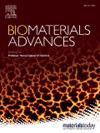聚乳酸纳米纤维/聚酰胺胺复合水凝胶作为体外神经再生和神经保护的新策略
IF 6
2区 医学
Q2 MATERIALS SCIENCE, BIOMATERIALS
Materials Science & Engineering C-Materials for Biological Applications
Pub Date : 2025-07-14
DOI:10.1016/j.bioadv.2025.214415
引用次数: 0
摘要
将静电纺聚l-乳酸(PLLA)垫在细胞黏附型聚酰胺胺水凝胶(H-AGMA20)中,设计了一种具有神经再生和神经保护性能的新型生物材料PLLA/H-AGMA20复合水凝胶。首先将聚乳酸薄膜暴露于乙二胺蒸气中,通过酯基氨解引入胺功能,然后用α,ω-丙烯酰胺端聚物(AGMA20)水溶液浸渍。最后通过紫外诱导自由基聚合固化体系。由于部分AGMA20丙烯酰胺末端与其表面胺基反应,得到的H-AGMA20基共价接枝到PLLA纳米纤维上,从而得到柔软柔韧的PLLA/H-AGMA20复合材料。在神经前细胞和免疫细胞系上进行的生物学研究表明,PLLA/H-AGMA20具有良好的神经再生特性,有效促进细胞增殖和神经元分化。此外,该复合物在体外表现出显著的神经保护作用,可抵消神经毒素1-甲基-4-苯基吡啶(MPP+)和促炎剂脂多糖(LPS)诱导的细胞毒性。这些保护结果似乎是通过调节炎症途径介导的,突出了生物材料在支持神经元发育的同时减少神经炎症损伤的综合能力。本文章由计算机程序翻译,如有差异,请以英文原文为准。

Poly-L-lactic acid nanofiber/polyamidoamine composite hydrogel as novel strategy for in vitro neuroregeneration and neuroprotection
A purposely designed PLLA/H-AGMA20 composite hydrogel incorporating an electrospun poly-L-lactic acid (PLLA) mat in a cell-adhesive polyamidoamine hydrogel (H-AGMA20) was investigated as a novel biomaterial with neuroregenerative and neuroprotective properties. A PLLA mat was first functionalized by exposure to ethylenediamine vapors, introducing amine functions through ester group aminolysis, and then impregnated with an α,ω-acrylamide-terminated oligomer (AGMA20) aqueous solution. The system was finally cured through UV-induced radical polymerization. The resulting H-AGMA20 matrix was covalently grafted onto the PLLA nanofibers since a portion of the AGMA20 acrylamide terminals reacted with their surface amine groups, leading to the soft and pliable PLLA/H-AGMA20 composite. Biological investigations performed on preneuronal and immune cell lines demonstrated that PLLA/H-AGMA20 exhibits promising neuroregenerative properties, effectively promoting both cell proliferation and neuronal differentiation. In addition, the composite demonstrated significant neuroprotective effects in vitro, counteracting neurotoxin 1-methyl-4-phenylpyridinium (MPP+) and proinflammatory agent lipopolysaccharide (LPS)-induced cytotoxicity. These protective results appear to be mediated by modulation of inflammatory pathways, highlighting the combined capacity of biomaterial to support neuronal development while reducing neuroinflammatory damage.
求助全文
通过发布文献求助,成功后即可免费获取论文全文。
去求助
来源期刊
CiteScore
17.80
自引率
0.00%
发文量
501
审稿时长
27 days
期刊介绍:
Biomaterials Advances, previously known as Materials Science and Engineering: C-Materials for Biological Applications (P-ISSN: 0928-4931, E-ISSN: 1873-0191). Includes topics at the interface of the biomedical sciences and materials engineering. These topics include:
• Bioinspired and biomimetic materials for medical applications
• Materials of biological origin for medical applications
• Materials for "active" medical applications
• Self-assembling and self-healing materials for medical applications
• "Smart" (i.e., stimulus-response) materials for medical applications
• Ceramic, metallic, polymeric, and composite materials for medical applications
• Materials for in vivo sensing
• Materials for in vivo imaging
• Materials for delivery of pharmacologic agents and vaccines
• Novel approaches for characterizing and modeling materials for medical applications
Manuscripts on biological topics without a materials science component, or manuscripts on materials science without biological applications, will not be considered for publication in Materials Science and Engineering C. New submissions are first assessed for language, scope and originality (plagiarism check) and can be desk rejected before review if they need English language improvements, are out of scope or present excessive duplication with published sources.
Biomaterials Advances sits within Elsevier''s biomaterials science portfolio alongside Biomaterials, Materials Today Bio and Biomaterials and Biosystems. As part of the broader Materials Today family, Biomaterials Advances offers authors rigorous peer review, rapid decisions, and high visibility. We look forward to receiving your submissions!

 求助内容:
求助内容: 应助结果提醒方式:
应助结果提醒方式:


